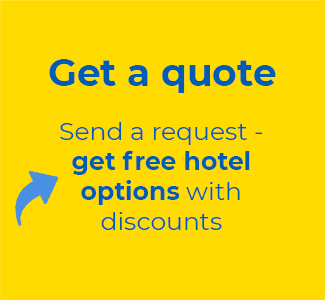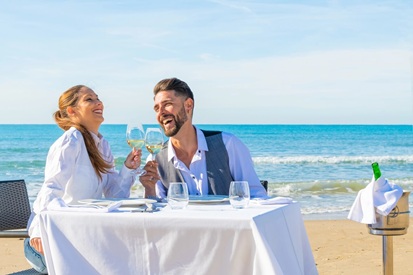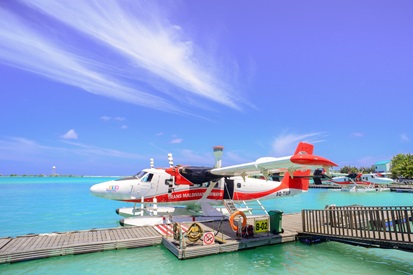

On the map, Male looks modest - a narrow island in the middle of the ocean, densely built with houses and roads. This is the heart of the Maldives, where the culture, religion, and independence of the island state were formed. What to do and what to see in the capital of the Maldives?
Facts about Male
- Male is the capital of the Republic of Maldives and its main city, located in the center of the archipelago, in the northern part of the Kaafu Atoll.
- It occupies the entire coral island of the same name and is one of the most compact capitals.
- It is one of the most densely populated cities in the world. The island’s area is about 9.3 km², but the population exceeds 200,000 people.
- Due to the shortage of land, buildings are mostly 5–10 stories high, and the streets are very narrow.
- The island is completely urbanized: there are almost no natural forests or beaches left.
- Male is surrounded by artificial breakwaters that protect against floods and storms.
- The Sinamale Bridge connects Male with the neighboring island of Hulhule, where Velana International Airport is located.
- Another nearby island, Hulhumale, is designed as a "new Male" and is being developed with modern residential areas.
- Almost all drinking water in the city is desalinated seawater.

Depositphotos
History of the capital of the Maldives: several stages
Long before the Maldives became a Muslim country, the archipelago was Buddhist. It is believed that the first settlers came from southern India and Sri Lanka – Dravidian tribes.
- In the 12th century, the ruler of the Maldives adopted Islam, which was a turning point in the country’s history. Since then, the city has preserved a unique structure – the Hukukroo Miskiu Mosque, or Friday Mosque, built in 1658. It is carved from coral stone and decorated with exquisite inscriptions – a rare example of Islamic architecture in the Maldives.
- From the 16th century, the Maldives became an object of interest for European countries. The islands became a Portuguese colony, then influence passed to the Dutch, and from the 19th century, to the British. In the 1930s, active modernization of the city began. The first banks, hospitals, educational institutions, and administrative buildings appeared. During this period, population growth accelerated, requiring infrastructure expansion. The authorities began demolishing defensive walls, clearing cemeteries, and leveling and widening roads to increase space for housing and construction.
- In 1965, the Maldives gained independence. Male became the political and administrative center of the new sovereign country. In 1968, the monarchy was abolished, and the country became a republic. President Ibrahim Nasir initiated a large-scale reconstruction of Male. Subsequently, Male began to actively develop as a modern city.
.jpg)
Depositphotos
Modern Male
Today, Male is a bustling and dynamic city. It is the center of Maldivian politics, economics, medicine, education, and culture. Here you will feel the real pulse of the Maldives: countless scooters, morning prayers from the mosque, the shouts of market traders, the aroma of spices, and the sounds of the surf. Due to the lack of land, Male is actively expanding onto artificial islands, including Hulhumale, connected to the capital by a bridge. Residential areas, schools, universities, parks, and next-generation hotels are being built here.

Depositphotos
Climate in Male
Male is located in the equatorial climate zone. There are no usual seasons here, and the climate is determined by the alternation of two monsoons: dry and wet.
- Dry season (iruvai) – from November to April. This is the most favorable time for travel. The weather is sunny, +28…+32 °C, dropping to +26…+27 °C at night.
- Wet season (hulhangu) – from May to October. Frequent short showers, air temperature from +27 to +31 °C. The sea can be rough.

Asad Photo Maldives
Population of Male
As of 2024, the population of Male, Hulhumale, Villingili, and Hulhule is about 211,000 people, which is 41% of the country’s total population. The population density in Male is extremely high due to the limited area of the island. The city continues to grow by expanding onto neighboring artificial islands, allowing for the creation of new residential and infrastructure areas.

Asad Photo Maldives
Administrative structure
Male is not only an island but also a separate administrative unit within the Republic of Maldives. The city is governed through a local government system and is part of the country’s central province, Kaafu Atoll. Male is divided into four main districts: North Male (the most densely populated and lively area), South Male (a residential area with many apartment buildings, schools, and hospitals, as well as some parks and recreation areas), West Male (the city’s commercial center), and Central (the historical district).
The administrative area of Male also includes nearby islands connected by bridges and ferries:
- Hulhule – the island of Velana International Airport.
Hulhumale – an artificial island actively being developed and expanding the city’s territory.
Villingili – a residential island accessible by water, also considered part of Male.
Male is the economic and commercial center of the Maldives, where the country’s main investments and business activities are concentrated.

Asad Photo Maldives
Transport in Male
Road transport is poorly developed in the Maldives, but Male is an exception. Traffic in the capital is intense, and roads are often congested, especially during rush hours. Despite the limited area of the island, the transport infrastructure is fairly well-developed. Motorcycles and scooters make up 77% of vehicles, being the most popular and convenient way to travel, especially in limited space and traffic. Almost all cars in the Maldives are concentrated on the island of Male.

Asad Photo Maldives
Bridges and roads between islands
The Sinamale Bridge, opened in 2018, connects Male with Hulhule, where the international airport is located. It is an important transport artery for travel between the capital and the country’s main air gateway. There is also a road between the islands of Hulhule and the artificial island of Hulhumale, which is actively being developed.
Public buses
Male has a bus network operated by MTCC. Buses run frequently on main roads from 6:00 AM to midnight, with limited service on Fridays.
Routes and fares:
- Route 101 (Airport, Hulhumale, Male Ferry Terminal): 7 MVR / 0.45 USD.
- Route 202 (Male Ferry Terminal, Villimale Ferry Terminal): 5 MVR / 0.30 USD.
- Route 205 (Hulhumale Hospital, Hulhumale Ferry Terminal): 3 MVR / 0.20 USD.
Bus fares are paid in cash to the driver upon boarding. Note that buses are overcrowded during peak hours, so they may not be ideal if you are carrying a lot of luggage.

Asad Photo Maldives
Taxis
This is the only island in the Maldives with a developed taxi service. You can easily hail a car on the street. Fares:
- First 2 km: 25 MVR / 1.60 USD.
- Each additional 1 km: 5 MVR / 0.30 USD.
- Waiting fee (for 10 minutes): 15 MVR / 1 USD.
A trip from the airport to the center of Male costs about 60–80 MVR, depending on traffic. Within Male itself – no more than 50 MVR (4–5 USD).
Tips:
- Ensure the driver uses a meter or agree on the fare before starting the trip.
- For a more comfortable ride, choose newer air-conditioned taxis.
Ordering apps:
Online taxi ordering apps operate in Male. Fares are similar to regular taxis but may surge during peak hours. Payment can be made online.
Due to local regulations, drivers of these services cannot pick up passengers directly at the airport or ferry terminal. You will need to walk a short distance to the pick-up point.

Asad Photo Maldives
Ferries (to other islands)
To explore nearby islands, take a local ferry from the main Male terminal on the southwest side of the island. Ferries are operated by MTCC and run frequently throughout the day.
- Hulhumale: 20 minutes, 10 MVR / 0.65 USD (every 15 minutes from 5:30 AM to 1:30 AM).
- Villingili: 30 minutes, 15 MVR / 1 USD (every 30 minutes from 5:30 AM to midnight).
- Gulhi: 50 minutes, 25 MVR / 1.60 USD (5 times a day).
- Maafushi: 90 minutes, 30 MVR / 1.95 USD (2 times a day).

Asad Photo Maldives
How to get around Male
One of the best ways to explore Male is to walk its bustling streets and soak up the local atmosphere. Most major attractions are concentrated in the compact city center, 10–15 minutes from each other.
Some popular walking routes:
- Along the beautiful waterfront from Republic Square to the fish market.
- Through the narrow streets of the Maafannu district, lined with traditional Maldivian houses and small mosques.
- In Hulhumale, a leisurely stroll along the coastal road at sunset.

Asad Photo Maldives
Bicycles in Male
Rent a bicycle and explore Male on two wheels. Many guesthouses offer free bicycles to guests, or you can find rental points along Majeedhee Magu, the main shopping street.

Depositphotos
What to see in Male
Male has beautiful and historical places that tell the story of the Maldives. Many of them are located in the city center, making them easy to visit during a walking tour.
Great Friday Mosque
The largest and most famous mosque in the Maldives, also known as Masjid-al-Sultan Muhammad Thakurufaanu Al Auzam or the Islamic Centre of the Maldives. Built in 1984, it is considered Male’s greatest architectural landmark, with a beautiful golden dome and white coral stone walls.

Depositphotos
Old Friday Mosque
A historical site worth visiting is the Old Friday Mosque. It is the oldest mosque in the country, built in 1656. What makes it special is that it is entirely made of coral stones. It is not as large as the Great Friday Mosque but has a rich history.

Depositphotos
Medhu Ziyaarai
A small shrine, the tomb of the famous Moroccan scholar Abu al-Barakat Yusuf al-Barbari, who brought Islam to the Maldives in the 12th century. Locals highly respect this place.

Asad Photo Maldives
National Museum
The National Museum is housed in what was once the Sultan’s palace. Inside, you will see various interesting artifacts from the Maldives’ past, such as old weapons, clothing, and household items. One of the most famous exhibits is an 11th-century coral stone Buddha head from the pre-Islamic era.

Asad Photo Maldives
Republic Square
A park in Male and one of the pleasant places to relax and enjoy the scenery. It is also a venue for various local festivals and celebrations.

Depositphotos
Male Local Market
A large open-air market where locals go to buy fresh produce, spices, and other goods. It’s a great place to feel the daily life of the Maldives. You can also find wonderful handmade souvenirs here. Only men are allowed to visit this market.

Depositphotos
Fish Market in Male
If you want to see something truly unique to the Maldives, head to the Male Fish Market early in the morning. This is where fishermen bring their catch for sale. Even if you don’t plan to buy anything, it’s very educational.

Asad Photo Maldives
Shopping in Male
Majeedhee Magu is the main shopping street running through the center of Male. Along this road, you’ll find all kinds of shops selling clothes, electronics, souvenirs, and almost everything else. Wear comfortable shoes – you’ll be walking a lot.
Bring cash (US dollars or Maldivian rufiyaa), as not all shops accept credit cards.

Depositphotos
Where to stay in Male
There are plenty of hotels of various levels and prices in Male. Most are located on the airport island of Hulhule and in the northern part of Male. There are almost no chain hotels in Male, but the market is developing rapidly, and international brands are expected to appear in the future.
- Hotel Jen Malé, Maldives by Shangri-La. A 4-star hotel in the business center of Male, close to the coast. Guests are offered spacious rooms with panoramic floor-to-ceiling windows, a rooftop pool and lounge, a fitness center, a restaurant, and a spa.
- Samann Grand. A 4-star hotel with stylish interiors, cozy rooms, and a restaurant with panoramic views of the city and ocean.
- Sala Boutique Hotel. Located in the center of Male, 5 minutes from the National Museum. It offers a homely atmosphere, comfortable rooms, and a restaurant with Asian cuisine. An excellent choice for those who prefer small, cozy hotels.
- Maagiri Hotel. A modern hotel near the seaport, offering spacious rooms, a restaurant, business services, and delicious breakfasts noted by nearly all guests.
- Rivethi Beach Hotel. One of the best hotels on Hulhumale island, offering clean rooms with sea views and a variety of water activities: snorkeling, fishing, diving, and windsurfing.

Hotel Jen Malé, Maldives by Shangri-La
More articles
- Mauritius Attractions: 27 Best Places to Visit
- Bali for Two: 24 Romantic Getaway Ideas
- Top 20 Bali Tours: Itineraries, Offers, and Prices
- Bali's Best Beach Clubs - 13 Luxury Oases
- Tips for tourists in Indonesia - how to avoid spoiled holidays
- Yoga Studios in Bali - where to catch Zen on the Island of the Gods
- Port Louis: All About Mauritius' Capital
- Seychelles Honeymoon Hotels: 9 Paradise Spots
- Bali's Best Eco-Hotels: Top 12 Spots
- Seychelles for outdoor activities - from diving to jungle trekking



